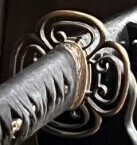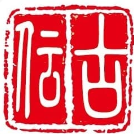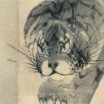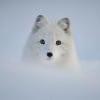-
Posts
160 -
Joined
-
Last visited
-
Days Won
1
Iaido dude last won the day on July 17
Iaido dude had the most liked content!
Contact Methods
-
Website URL
hyotanantiquesandcollectibles.com
Profile Information
-
Gender
Male
-
Location:
Gainesville, Florida
-
Interests
Sukashi tsuba (up to early Edo), iaido, kyudo, Japanese zen paintings (pre-17th century)
Profile Fields
-
Name
Steve Hsu
Iaido dude's Achievements
-
Yes, I noted that one of the differences was the massive "Ko-Shoami" style seppa-dai along with the more rounded central motif that has been the focus of discussion for much of this thread. The end of Ko-Shoami production and the brief period of Kanayama tsuba production coincide during the Momoyama Period, although I don't have knowledge of geographical overlap and likelihood of cross-influence. Ko-Shoami and Kanayama tsuba continued to be produced into the Early Edo Period with some loss of the vitality associated with Momoyama period guards. It was listed and sold on Jauce several months ago for a higher price. There was considerable interest, but I didn't set my max high enough at the time. Then it was listed again to my delight and again generated interest, but I had the successful bid this time. I am considering whether to mount it on my practice iaito, which needs a lighter tsuba such as this one. The aggressive ji-sukashi with motif in negative silhouette achieves the 97 gm weight. It would be even lighter if it were a more traditional <7 cm Kanayama tsuba. Interestingly, Ito san's example approaches 8 cm, which is impressive.
-
One of the sections in Koichi's link of Ito Sanpei san's commentary caught my eye, which speaks to the issue of symbolism and meaning. He includes both sides of the enjoyable argument about the artist's intension (explicit vs. unknown/unknowable). I would argue that the more Buddhist the iconography, the more likely that the latter predominates. In my conversation with Ito Mitsuru, I don't think it's possible to make a tsuba that you can't explain the design of at that point when you make and sell it. Sellers also use sales pitches such as "This is a copy of XX, so it's good luck" or "It's popular in the capital right now". When making a tsuba to order, I think the customer specifies the design with a specific intention. However, there are many tsuba classified as Kanayama tsuba whose design intention is unclear at this point. In the introduction to the characteristics of Kanayama tsuba in "Open Tsuba: Beauty of Bushido" (by Sasano Daigyo), it is mentioned that "There are many square-mimi (square edges), thick tsuba, many tsuba with unclear meanings, and steel bones protruding from the tsuba edge, and they are small tsuba by design. "However, the designs of Kanayama tsuba from the Momoyama period, which is a later period, include the "Matsukawabishi tsukashi" in our collection, as well as "Tsurigake tsukashi," "Shining light tsukashi (clock tsuba)," "Lightning tsukashi," "Thunder pattern tsukashi," "Shadow scale tsukashi," and "Jojo tsukashi," and while the intention is unclear, there are aspects of the designs that are easy to understand. In modern times, it is called "unknown watermark", but I think it was a well-known design at the time. However, compared to the designs of other schools of swordsmen, such as old swordsmiths, old armorers, Kamakura, Heianjo inlaid tsuba, Owari watermark tsuba, and old Shoami tsuba, the Kanayama tsuba design is unique. I think that the reason for this uncommon design is that it was made with the assumption that it would be used within a certain organization (for example, a specific school of swordsmanship like the Yagyu tsuba, or for the warrior monks of a specific temple) rather than with the intention of selling it widely on the market... And of course many motifs were simply a family mon, which was stylized and abstract, but also symbolized some meaningful martial ideal, omen of good luck, or some utilitarian purpose that favored victory with perseverance and valor. I have just ordered Sasano Daigyo's book since it is so heavily referenced by Ito Sanpei san.
-
I'm still not at all certain what the motif represents, I couldn't agree more that it is in the small details that we sometimes discern a new semiotic attribute. This is especially true with more abstract representations. Claude Levi-Strauss believed that the human brain has a structure such that symbols manifest in a restricted range that is repeated throughout human history, often in cultures that had no clear opportunity to interact and share meanings. Carl Gustav Jung believed that there is an inherited underground subconscious cavern from which we may dip a ladle and drink deeply. This is conceived of as a transmitted repository of symbols--this a place that may provide content for our dreams. I am attaching an article that I published in 2000 about the inter-relationship between science and art, where I explore some of these concepts. Pharos Summer 2000 p. 11.pdf Pharos Summer 2000 pp 12 - 13.pdf
-
Koichi, thanks so much for the link. What an amazing commentary on precisely this Kanayama tsuba motif as well as the type of tekkotsu that may be found in early Owari Province tsuba. My tsuba is different than the majority composition of this kind in being more “curvaceous,” which is what appeals to me. There is a lot for me to consider and digest with more leisurely and dedicated study. It has enhanced my enjoyment of this piece immensely. It is natural it seems that what is beautiful, mysterious, and evocative to our minds, as in the case of this motif, becomes an invitation to find meaning through it. Without the possibility of time travel to ask the tsubako what he intended with this creation, we may need to depend on historical clues from prevailing cultural and aesthetic trends, geography, and just the simple pleasures in life such as watching steam rise from boiling water.
-
Dale, that "reversed" design is interesting. Another great Kanayama tsuba. Very appealing piece. I love that blog, but I cannot for the life of me figure out how to search that collection of hundreds of top notch guards for a specific category.
-
Iaido dude started following Kanayama Tsuba ("Namako" Sea Cucumber Motif)
-
This is a recently acquired Kanayama tsuba "study piece" costing just over $300 on a Jauce auction. It has a massive seppa-dai and large lump-type tekkotsu concentrated on the upper mimi clockwise between 7 o' clock and 1 o' clock (two are shown in pic). There is a slight dishing from mimi to seppa-dai. This is a genuine Kanayama, but has some unusual variant features. The motif on the left and right of the seppa-dai and forming the hitsu-ana is often referred to as "sea cucumber" (namako) and made famous by the tsuba of Miyamoto Musashi. However, I highly doubt that he was thinking of a deep sea creature to decorate a sword fitting when he adopted this abstract motif as part of the simple and symmetric composition commonly found in Kanayama tsuba. This tsuba is almost certainly a product of the Momoyama Period with a lively flow of curves in the composition that is mesmerizing and evocative of Wabi Tea and Zen Buddhist aesthetic principles including wabi, sabi, and mono no aware. For me it is also an especially powerful evocation of yugen (mystery). Beyond the tekkotsu there is variation in thickness going around the mimi and the seppa-dai, which exaggerates the rustic spirit of the overall effect. The surface has an unusual appearance comprised of an exaggerated and coarse cobblestones/craters (not sure if it can be described as tsuchime-ji) interrupting a beautiful yakite-shitate surface treatment. This seems to be an intentional aesthetic expression rather than reflecting any corrosion of the patina, which has a lovely color. There is an almost identical example of this tsuba in "Openwork Tsuba" by Kenichi Okubo, et al (page 192) that is more of a classical Kanayama tsuba in its features. The major differences are that the width of the motifs on either side is even less uniform in my tsuba, being thinner at the center so as to create almost the appearance of upper and lower lobes, it has a massive seppa-dai measuring 47 x 27 mm (reminiscent of Ko-Shoami), and it has an unusual linear gouged tagane pattern around the entire nakago-ana. It appears to have been mounted many times, which may attest to the aesthetic value placed on this tsuba. There are a few other similar pieces found on my Google search, but they are linked to NMB posts that apparently no longer exist. The major differences are whether there is a kogai hitsuana or if both are kozuka hitsuana, and whether the curved element that forms the hitsu-ana is joined to the mimi in a more round shape (relaxed), such as in my tsuba, or at a more acute angle (stiff) as in the reference piece below. Diameter: 76 mm Width: 5.7 (mimi), 5.0-5.3 mm (seppa-dai) Weight: 97 gm
-
Steve, nearly everything I know I learned from you!
-
Beautiful, Curran. Your comments ring true for all categories of tsuba. There is no substitute for hard-earned experience and expertise. Is the second one a recent acquisition? I was looking at the same tsuba or a very similar one not long ago, but passed because I limited myself to previously published designs and couldn’t assess the materials.
-
Deanna, thanks for starting this post. The subjects of Yagyu and Ono/Ohno are always of interest because the characteristics of these categories are often less well established. One of the things to keep in mind about attribution is that after Early Edo when the pure provincial influence that characterizes tsuba we refer to as Kanayama, Owari, etc, gives way to cross pollination, it becomes increasingly the case that there is a merging of influences as tsubako begin to travel and intermingle in capital cities and major trade hubs. The smiths never labeled themselves the way we seem to refer to them because of the almost obsessive need to pin down the attribution. Often they produced tsuba in numerous styles simultaneously based on the market demands including special commissions from patrons. For example, we sometimes find tekkotsu on styles of tsuba that we don't usually associate with this kind of feature. There is no reason to think these smiths limited themselves so strictly with regard to interpretation or execution. Short of authentic mei that identifies the smith, we are using inductive reasoning (in the best case scenario) to identify features of one or more categories. Eckhardt Kremers has postulated convincingly that the Kyo-sukashi, Owari, and Ko-Shoami styles were major influences on the features of Akasaka guards because these were being produced simultaneously by a Shoami master who moved to Akasaka with several Owari tsubako to set up a workshop. Beware guards like the teapot above. The surface treatment looks manipulated with wax to cover up damage to the patination. Such guards may have attribution from shinsa, but the condition is not part of the judgement.
-
Here is an Ohno that has been cycling on Jauce, which I am a bit suspicious of because of the surface treatment. Can’t tell if it’s just a photography issue. It looks to have been waxed, although not as jet black as some of them and some rust color is coming through. This seller does not routinely blacken his sukashi tsuba, so there is some hope. There are scratches around the seppa dai on the ura, but these could be smoothed over gently with some horn, I suppose. The dimensions are consistent with Ohno and there is the characteristic sinking of the central motif below the rim to give that powerful feeling that we experience with a dished tsuba. I think that the design is a bit stiff, but wouldn’t be a dealbreaker on its own because I like the strong and stark martial quality of this guard. https://www.jauce.com/auction/f1160853554
-
I have seen this on Jauce and discussed with Steve Waszak. If this is a Yagyu, it is a late one. The surface treatment is very coarse, which is not the way the "sandy," but smoother and uniform appearance of Yagyu plates appear. That uniform coarseness is not produced by tekkotsu, which are absent on this tsuba. The motif and composition are not one of those 269 designs in Haynes' Yagyu Design Book (I have confirmed this). It is also thinner than an early Ohno, which is nearly always >6 mm at the rim. My Ohno Kuruma 8-spokes tsuba (see Peter's insert of my original post) is 7 mm at the mimi and 4 mm at the seppa dai, which is a consequence of the steep step-off as in the current tsuba under consideration. The central 6-spoke motif is likewise sunken for a powerful appearance. If not for the coarse surface treatment, which likely reflects corrosion of the original patina, I would have seriously considered this tsuba because of its Buddhist iconography (6 paths of karma)--a specific and focused collecting interest for me. If it speaks to you, that is all that really matters in the end. This would be a low-risk, low-cost acquisition--also a study piece to examine in hand.
-
There are many beautiful aspects to your 4th tsuba-smithing attempt! I especially like the execution of the 3-D sculpural aspect, which seems like it would be the most technically challenging.
-
It's a bit thin for Ono.
-
I agree, but I think those people post-Early Edo were the merchant class rather than the buke. There is no religious imagery here, just Western-influenced bling that spoke to wealth and social standing rather than spirituality.
-
Fantastic, Ed. I'm a big fan of bonsho and have been waiting to see rarer Kanayama/Ono examples that are more lively than the frequently encountered Owari. What are the dimensions?











